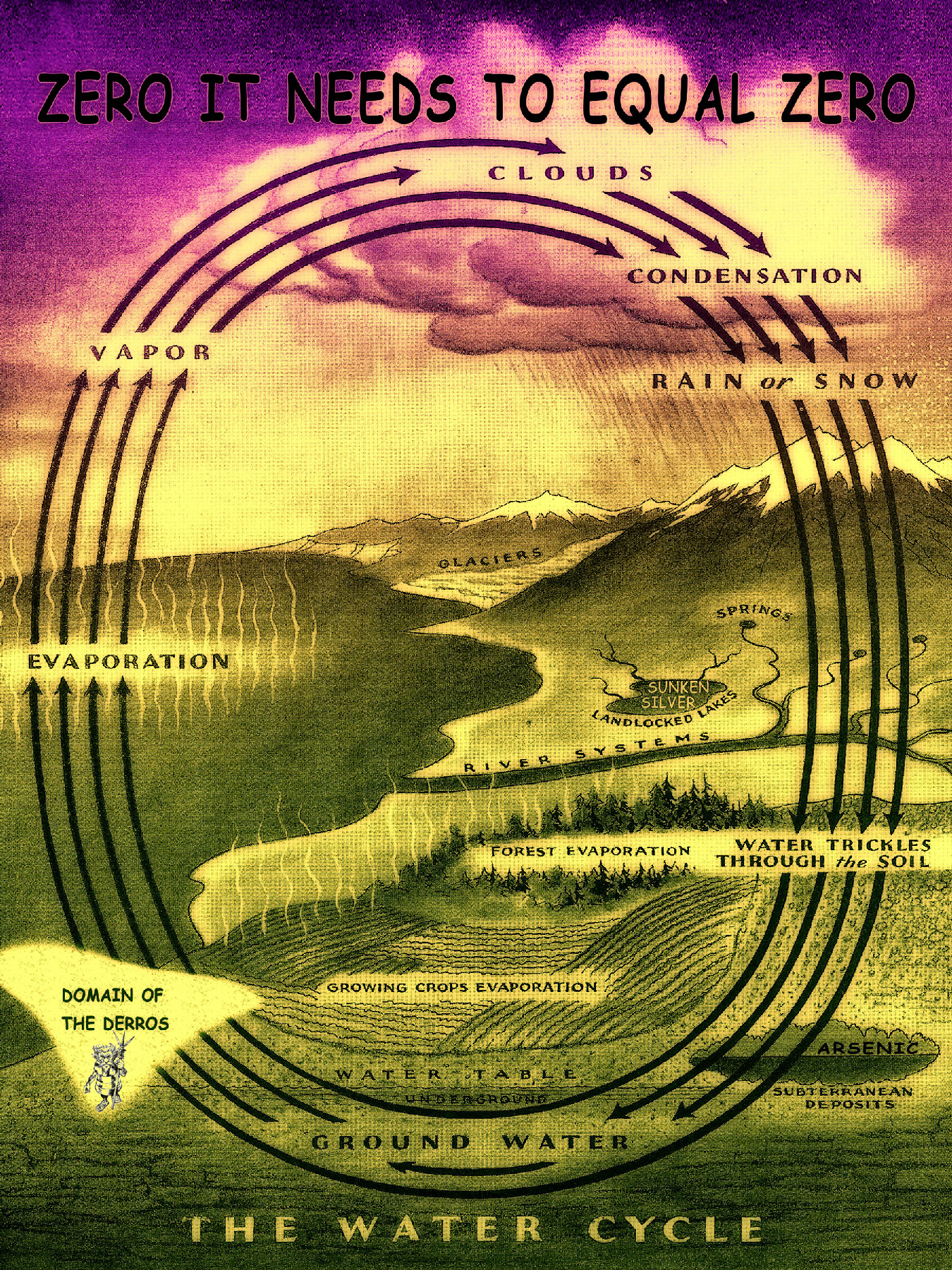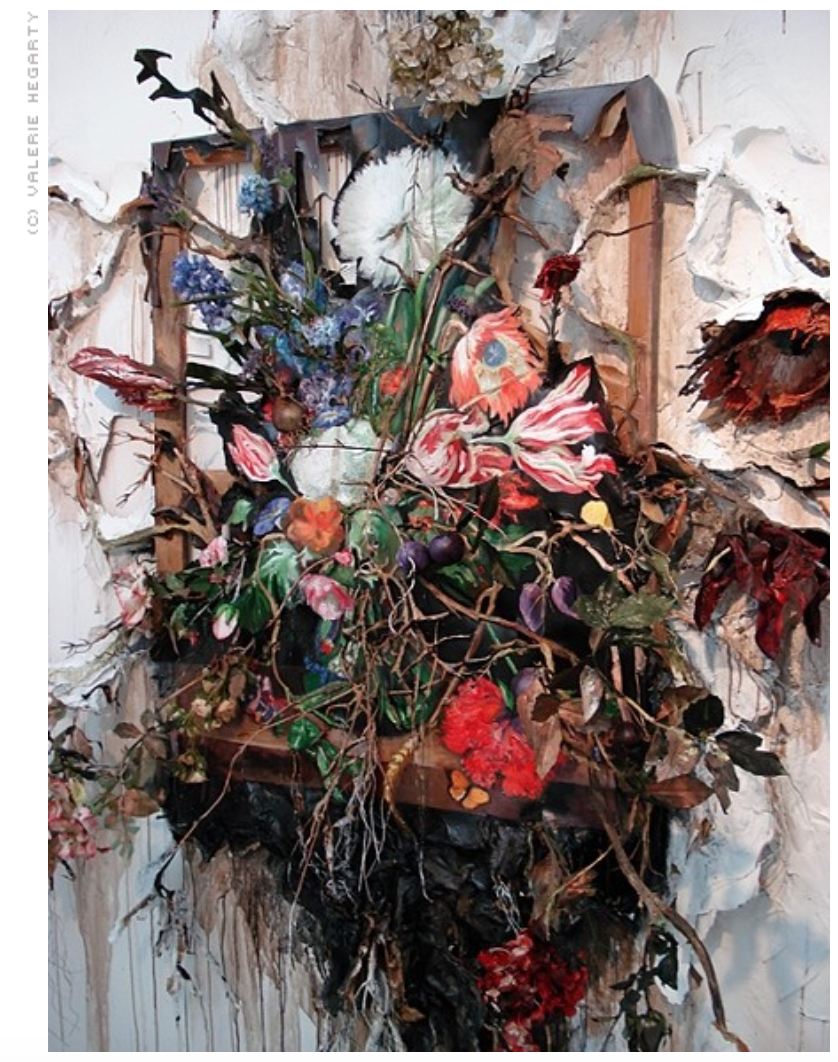
Acrylic on paper, 60 x 40 inches; Silk and plastic flowers with found materials and acrylic paint, 50 x 40 x 40 inches. (respectively)
From Realizations exhibition at Victori + Mo, Brooklyn, Spring 2017
In the six years I’ve known Sam Stabler, we’ve collaborated several times, culminating in exciting shows in New York and Los Angeles. In these projects, Sam has stayed the course, creating paintings from his two major series, the Cut-outs and Old Masters, while I’ve contributed in various ways with my words. After our first show I got giddy when Sam told me he liked my writing, because he makes beautiful things, and anything I wrote those days was certain to include flourishes like “shit” and “fuck.”
The first thing most people notice about Sam is his beard. It’s gruff and foresty, but elegant too. Sam’s beard is fit for an outdoors-gentleman, the paradox in facial hair that folk in Williamsburg have aspired to for years. The second thing people notice is his voice. It’s big and bassy, full of charm. You can talk to Sam for an hour and feel like the whole time you two have just been spinning yarns. But if you’re lucky enough to interview him, which I have been (once in 2011, and now in 2017), the transcript will reveal this artist’s gift for discourse and his instructive, studied perspective on the craft.
Over the years I’ve also collected Sam’s work. An early painting from his Old Master series—an ink reproduction of a film still from Butch Cassidy and the Sundance Kid—hangs above my couch. Aside from a few isolated sections of pale gray in the picture, a single neon yellow rectangle screens the gun-slinging cowboys. In newer pieces, Sam layers his ink reproductions—of bacchanals, political banquets, berry and rose bouquets—with dazzling geometric patterns in soft shades of pinks and purples and blues and greens. This creates an interesting duality. At a distance the Old Masters remind one of Agnes Martin’s colorful and subtle compositions, but up close the iconic images dialogue with a very different artist like Richard Prince.
Sam’s other major series, the Cut-Outs, employs the exhaustive practice of tracing subjects on paper from many sources. He painstakingly cuts out these subjects’ outlines with a razorblade and combines them with other subjects, creating an abstract attack. Look! bam, that’s strange viscera in your face. Look longer and a sinewy logic will emerge. Staring at Sam’s Cut-Outs is like when you’re in a forest at twilight and don’t feel like going back to the car yet so peer up at the erratic web of branches interfacing with the changing sky, the world darkening by pretty increments. Yup, that’s them, in my opinion.
The Cut-Outs are curated through intuition, like Sam’s beard.
I press the artist’s contact on my phone to begin our interview, which—life, busy schedules—is a good excuse to catch up with a friend I haven’t talked to in a long time. When Sam picks up, I learn that he’s standing outside in Georgia with his youngest son. He has moved south with his family after a long time working and showing his artwork in New York. I imagine big trees and a light breeze. Where I am in Manhattan a tire pops right below my window and a man screams in what sounds like stuttered ecstasy or some last impassioned death gasp. Sam and I talk for an hour. Every so often—beneath the artist’s voice, his child croons.
Sam: Kyle! How are you, man? How’s New York?
Kyle: Hey! I’m not sure. There’s someone yelling outside my window…
Sam: Uh oh.
Kyle: Yerrrp. So, Georgia! How’s that? What’s your setup over there?
Sam: It’s not too bad! We have a little place in Athens. It’s a fixer-upper, an old Spanish colonial, stucco. It looks like a house in LA, unusual for Georgia. I’m doing a lot of work on the place—I mean, it was in rough shape. Which, you know, is why I could afford it.
Kyle: Ha! Very nice. I hear you’ve got a show in Atlanta coming up. Can you talk about that?
S: I can’t really explain why I’m so excited to show in Atlanta. I suppose it’s just this deep-rooted hometown desire. I’m from Atlanta, of course…well, not of course, but you knew that, I think you knew that, right?
[Sam laughs]
The show will be at Laura Hathaway Gallery, and I feel like Laura is part of the generation of the art world that is working together to send the message to international artists and collectors that one no longer needs to live and show in New York to establish themselves. The art world is changing and I feel like a lot of us are committing to these smaller cities.
K: Do you have a vision for that show?
S: The space in Atlanta is huge, phenomenal. It’s like a Chelsea gallery. That’s a fun challenge, one I’ve never been presented with. I’ve got 10,000 sq. ft. potentially at my disposal, so what am I gonna do with it? There’s something liberating about that much space. In NY I showed a floral sculpture, which was a re-interpretation of a floral painting of mine, which in turn was a re-interpretation of an old still life. So I went full circle, and I was surprised by how much I enjoyed that. For the Atlanta show, I’m thinking about having a floral sculpture in the central space, and different manifestations of my floral paintings surrounding it. One that’s got a pattern on it, one with spliced sports images, another with movie stills, advertising, and C-SPAN type imagery, all flanking a physical sculpture of these flowers.
K: By the way—I’m looking at an image of one of your floral sculptures online right now. What material are you using for these?
S: It’s like friggin’ plastic flowers! Hobby Lobby stuff! Michael’s shit, it’s great. I love going into that store. I spend $500 on plastic flowers, it’s phenomenal. I don’t know if you’ve been in a Michael’s recently, but it’s a unique experience, man. The cashiers always ask me, “Who’s the lucky lady??” because I have these stacks upon stacks of fake flowers in my cart. And I’m thinking, I don’t know! It’s not gonna be my wife, because she’s gonna be pissed that I bought all this crap! So it’s all cheap materials. This, actually, is at the core of what I do, the reason I work on paper is because I didn’t want to have a $200 stretcher that’s so precious I’d be afraid to let it go. So like with the paintings, the sculpture materials are also cheap. If I screw up, no big deal. I can just get another one, I can repaint it, I can figure it all out.

Hand-cut paper
30 x 22 inches
K: I’ve been lucky to experience your work over time, and one thing I’ve found interesting is that you’ve never drastically switched up your practice. Instead, it seems, you’ve been constantly fine-tuning your project, and over the years the work has become more rigorous, more complex. So, where did it start? What are you reaching for? Have the goals changed over time?
S: I don’t think the goals have changed. From youth…er, I don’t know what I’m gonna call youth…but let’s just leave it at ‘youth’ whether that means college or grad school… I’ve always thought, How is my practice going to look, collected? 50 years from now, what is it going to look like? I like that you said that I’m honing my craft, because I am. I want to be better and better. It’s a slow progression. I think of Ed Ruscha’s body of work, right, Ed Ruscha. Let’s say he made one word painting…it’s kinda like… “eh.” But if he makes a year’s worth of word paintings it’s more like “Oh okay, a whole year.” Ultimately, this guy’s got a lifetime of word paintings. The idea is that his craft hasn’t changed. He still paints. He’s added works in hologram, works in books, works in print, but in the end, the core of his practice is paintings that use text. And the more he makes, the better each one of these paintings gets, in my opinion.
So, in the way that volume and longevity lend itself to his practice, I’m hoping that it’s the same with my practice too. With every Old Master that I redo, with every film still, I hope it makes all the earlier ones more relevant and informative as a collective body. That’s the plan. I’m trying to slowly move forward, but stay committed to the core. I feel like I have a good base, a good level of skill in my practice, where there’s plenty of lateral steps to explore. I don’t have to suddenly move into oil painting, or installation art, but if an avenue opens itself up to pursue—like recently I made a wallpaper—I’ll do that. In other words, my practice doesn’t lend itself to radical change. It’s a slow burn.
K: A slow burn, baby! A cheesy analogy comes to mind: seeing your work over time is like watching an athlete grow throughout their career. You can appreciate their style of play more and more the longer you’ve been familiar with their game. I look at some of these new Cut-Outs and Old Masters, and they just pop to me, both visually and because of all that history.
S: Good! That’s good, I like that. Look, man, I love sports analogies. I’m not comparing myself to LeBron James—let’s be very, very clear—but there’s this idea of longevity that I’m interested in. One of the things that makes LeBron James such a unique athlete is not just his skill-set, but how long he’s been good. That’s an underrated characteristic of evaluating athletes. There are athletes who are awesome, but burn out. That’s fine, but I favor longevity. My word today. LeBron, by the way, always mentions how it’s a waste of time comparing oneself to contemporary peers as everyone is so different and we should be happy for everyone’s success. LeBron only compares himself to history. Artists value that too.♦

Acrylic on paper
14 x 58 inches
Samuel Stabler (b. 1984, Atlanta, Georgia) studied at Central Saint Martin’s College of Art and Design in London, and the University of Georgia, Athens, in 2007. His work has been exhibited internationally in New York at Garis & Hahn, Dorfman Projects, Gallery 151, National Arts Clubs, and Christie’s; in London at Degree Art Gallery, The Conningsby Gallery, and The Window Gallery; Gallery 60Six, San Francisco; Subliminal Projects Gallery, Los Angeles; Tumuboko Gallery, Kobe, Japan; the Chinese Characters Gal- lery, Budapest; and The Co ee Shop Gallery, Brussels.
Kyle Kouri is an MFA candidate in fiction at Columbia University. He also makes visual art. His most recent exhibition, “Long After You’re Gone,” opened at 7 Dunham Gallery in April 2015. His stories have been published in Cleaver Magazine and Horror Sleaze Trash. He is also the Online Arts Editor for the Columbia Journal. You can follow him on Twitter and Instagram @kylekouri.




